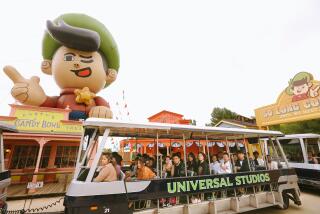One tiny amusement park’s obsession with bringing back the retro thrills of the wooden toboggan coaster
Coaster enthusiasts thought the rebirth of the Flying Turns wooden toboggan coaster at Pennsylvania’s Knoebels amusement park might never happen.
The family-run park in tiny Elysburg spent eight obsessive years building and rebuilding a faithful replica of the slow, squat and serpentine coaster that disappeared from the amusement park landscape more than four decades ago.
I visited Knoebels for the first time during the summer of 2011 and took a guided tour of the track of the then-unfinished Flying Turns. I returned to the park late last month to finally ride the classic coaster.
The ride started out slow, but quickly built to a thrilling pace. The trackless car climbed higher into each banked turn we tackled. The switchback course and high wooden walls left me with no opportunity to anticipate what would happen next. I was certain the train was going to tip over in the last few overbanked turns.
Traditionally, the trackless toboggan-style rides feature a wooden chute where a coaster train glides freely like an Olympic bobsled through a twisting course at a top speed of 25 mph.
The challenge of building a one-of-a-kind, modern-day version of a classic ride is just that: There’s no working version to compare it to. Only old plans, grainy photographs and the recollections of a few Flying Turns veterans.
Originally designed by World War I aviator John Bartlett and John A. Miller, known as the “Thomas Edison of Roller Coasters,” the first Flying Turns bobsled coaster was built at Lakeside Park in Dayton, Ohio, in 1929.
Despite the Great Depression, Bartlett and Miller built a total of eight Flying Turns-style rides, with the best-known version at Euclid Beach in Cleveland. The last one standing, the Bobsled at New York’s Coney Island, was demolished in 1974, according to Roller Coaster Database.
Opened in 1926, Knoebels is probably the only place on Earth where the extinct Flying Turns could rise again. The quirky, traditional, family-run park, which still offers free admission and free parking, retains a passion for resurrecting and rescuing old rides.
The Phoenix wooden coaster, rebuilt at Knoebels in 1985, started life at a Texas amusement park in 1948. A 1960 steel coaster from a New Jersey oceanside park was transformed in 2011 at Knoebels into the three-story Black Diamond dark ride and indoor coaster. The park is also home to a host of classic rides, including a whip, looper and roll-o-plane.
Based on the Flying Turns model at Chicago’s Riverview Park, the 47-foot-tall Knoebels’ version of the ride has three lift hills, a 540-degree helix and a signature double figure-eight trough. The 1,300-foot-long half-pipe track features a durable and forgiving hardwood surface made of cypress. Lined with thin strips of tongue-and-groove wood, the trough track looks like a cross between a weather-beaten boat deck and a hardwood basketball court.
Coaster fans salivated when Knoebels first announced plans to build Flying Turns in late 2005. Construction began in early 2006. By late 2007, following successful test runs, Knoebels felt confident enough to give coaster enthusiasts a walking tour of the twisting track.
Then trouble started. The design of the ride vehicle presented problems. The wheels had to be shipped back to the manufacturer. The cars were too fast and wild to carry passengers. The track had to be redesigned and modified to accommodate new trains. Then the new cars jackknifed during a test run.
The main challenge was updating a 1930s ride to modern standards that would meet with approval from state ride inspectors and the park’s insurance carriers. The hardest part: designing a train with the perfect combination of size, weight, length, height and appearance.
Through it all, the park persevered and Flying Turns finally opened to the public in late 2013.
For me, it was worth the wait to climb aboard a classic ride that I thought had been lost to the ages.
Still need more theme park news? Check out the Los Angeles Times Funland theme park blog on Twitter, Facebook, Google+ and Instagram.
ALSO
8 unanswered questions about Disneyland’s Star Wars Land
Disneyland 2055: What the future may hold for the original Disney park
Disneyland 1955: ‘Walt’s Folly’ got off to a nightmare start
21 creepiest abandoned amusement parks
More to Read
Sign up for The Wild
We’ll help you find the best places to hike, bike and run, as well as the perfect silent spots for meditation and yoga.
You may occasionally receive promotional content from the Los Angeles Times.







